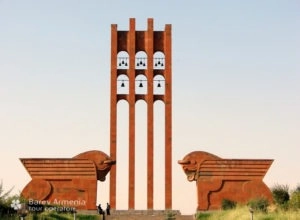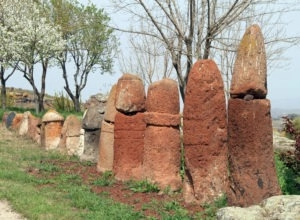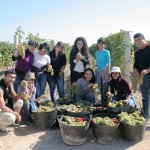Ancient Armavir

Founded: 1032 BC. e.
Height: 870 m
From Yerevan: 45.6 km / 49 min
Historic Armavir is close to the village of Haykavan on a huge hill. The citadel of historic Armavir was on top of this hill with the town neighbourhoods around it, 17 cuneiform inscriptions of Argishti I, Sardour II, Rusas I and Rusas III tell us about the founding of the city as well as its defence and court structures.
In 776 BC, King Argishti 1 built the city of Argishtikhinili – the economic, cultural and worship centre of the Urartan Kingdom. It had 2 citadels with royal palaces, temples, workshops, grana-ries and wine cellars. The people called Argishtikhinili – Aramayr (mother).
Khorenatsi attributed the founding of the town to Aramayis, Forefather Hayk’s grandson (III millennium BC). The description of the historian is concise, ‘Aramayis builds a house on a hillside on the bank of the river for dwelling purposes and calls it Armavir after himself. The river he calls Yeraskh after his grandson Yerast.
The Greek historian Ptolemy mentions Armavir as a town. In III-II BC, it was a large centre of worship. The town housed the Temple of Sun, the chief god, the temples of pagan Armenians and the gilded statues of Artemis and Apollo. Pieces of the citadel ramparts and walls of buildings, metal items, weapons, clay statuettes and jewels were discovered. Of interest is the gold pectoral (VI-IV BC), which is a perfect piece of art. It symbolizes the skill and taste of Armenian jewelers. The town had roads linking it with the Caucasus, Mesopotamia, Assyria, Iran and the countries on the shores of the Mediterranean and Black Seas. Armavir survived till V c. and was no longer mentioned afterwards.
The famous Plane-Tree Forest is in the neighbourhood of Old Armavir. The plane-tree is a religious and sacred tree. It is the forefather of Armenian trees and the symbol of pagan Armenia, equal to Massis. Armenians used to go to the battlefield with standards depicting the plane-tree forest. The pointed leaf of the plane-tree was the symbol of God Hayk. Armenians sowed wheat under plane-trees.
The hero of the forest was Anoushavan, the son of Ara the Handsome. His nickname was Sosanver (a gift to plane-trees). The main temple devoted to the plane-tree was in Armavir and was surrounded with the Plane-Tree Forest. Pagan Arevordi (son of the sun) priests made charms and forecasts listening to the whispers of trees. According to Khorenatsi, ‘People used to tell the future depending on the calm or severe noise of the leaves.’ In the opinion of the German archaeologist P. Kalmeyer, the trees and the spear-shaped leaves and branches in the pictures and haut-relief sculptures dating from the Kingdom of Ararat refer to the fortune-telling practice described by Khorenatsi. Darius called the leaves of this tree Armenian miraculous leaves.
The plane-tree is also known among Armenians as chinar. Both have become human names: Sos (male) and Chinar (female). The Plane-Tree Forest survived for 2300 years (XXV-III BC). It has left no traces but a name. However, Armenia could not have lived without the sacred forest. The Plane-Tree Forest in Armavir was immediately succeeded by the Christmas Forest in Bagaran.
Zvartnots Temple is in the same region.







